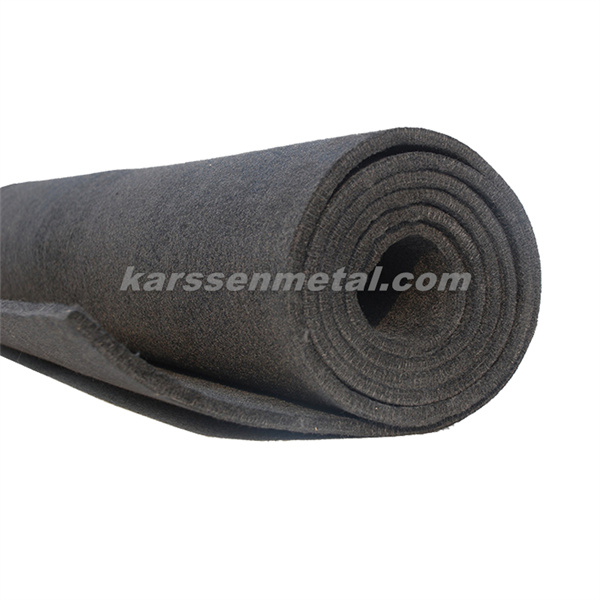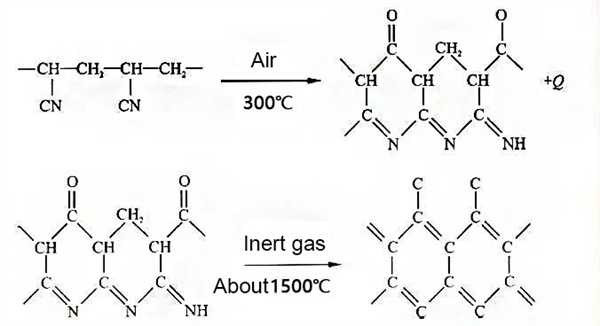Email: info@karssenmetal.com Tel: +86 18147353336

Carbon fiber felt has good electrical conductivity, and its temperature resistance can reach 1300 ℃. It is often used in a long-term high temperature environment, such as a single crystal ingot furnace, to play the role of heat insulation. The production process of carbon fiber felt mainly consists of the following four steps:
1. Carbon felt impregnation and drying process: After the raw viscose fiber cloth is inspected, it enters the 1% phosphoric acid diamine prepared in the impregnation tank, soaks it in the aqueous solution for 1 hour, and then enters the continuous extrusion equipment for extrusion after being taken out. The extruded diammonium hydrogen phosphate solution is returned to the impregnation tank. Use natural light to dry on a drying rack or use a dryer to dry.
2. Carbon felt carbonization treatment process: the dried viscose fiber cloth enters the carbonization furnace and heats up to 300°C. The temperature rises first slowly and then quickly. Nitrogen pipes are distributed at the bottom of the furnace, and nitrogen gas is introduced into the furnace as protection gas during product carbonization process. Carbonization is a process of removing volatile non-carbon components in fibers, increasing the carbon content and purity of products, and forming carbon fibers with a graphite-like microcrystalline structure.
3. Carbon felt activation treatment process: The carbonized viscose fiber cloth is heated to about 1400 ℃ (the temperature in the furnace) for activation, and the activated carbon fiber felt is the crude product. At the same time, steam is passed through, and the fiber felt cloth is perforated with a high temperature resistant tube, so that the surface area is increased, and the finished carbon fiber felt is obtained. The so-called activation process is to add a catalyst (such as nitrogen) to increase the number of activated molecules in the entire reaction, so that the properties of carbon molecules and atoms become more active and have greater energy.
4. Slitting and rolling: After the through-hole carbon fiber felt is naturally cooled, the slitting machine, cutting machine and rolling machine are used to cut the corresponding size according to the sales needs. After cutting, roll it and temporarily store it for sale.
Since 90% of carbon felt is void, its thermal insulation performance in vacuum or inert atmosphere is excellent, especially under high temperature conditions. Many people know a lot about the production process of carbon felt, but know little about the carbonization activation principle of carbon felt.
Carbonization and activation of carbon felt is an important process in the production of carbon fiber felt, and it is also the key to determining the void structure and performance of the product. The impregnated viscose fiber is non-melting and non-combustible at high temperature and keeps the fiber shape. Cellulose fibers are carbonized and cracked at high temperature, and other non-carbon materials are cracked into small molecules or run away in other gaseous forms. After pyrolysis, the non-carbon atoms escape and undergo a polycondensation reaction to generate a turbostratic graphite structure. At room temperature to 130 ℃, the viscose fiber will remove the physical adsorption moisture, and the macromolecular main chain will break at the same time of dehydration at 270-400 ℃ (temperature in the carbonization furnace).

8%-10% of the CO2 and H2O small molecules bound in the carbon felt raw fiber escape and release NH3. Carbonized in a thermally stable state, driving away non-carbon atoms, and turning black with high temperature oxidation. During the carbonization and activation process of the fiber, the nitrogen, oxygen and hydrogen elements contained in the fiber are released in the form of H2O, CO2, NH3 and N2 and fiber become carbon fiber. The reaction formula is:

Carbon felt carbonization and activation are complex physical changes and structural transformation processes, which are thermal decomposition and thermal polymerization processes under the protection of inert gas (N2) in the furnace. The end result is that the trapezoidal structure formed by the oxidation process is transformed into a carbon fiber turbostratic graphite structure. This process includes the breaking of carbon-carbon bonds and the polymerization between functional groups, and the generated gases are mainly CO2 and H2O. Low-temperature carbonization gradually enriches carbon elements, and the temperature increases into activation, so that the carbon structure is gradually fixed. Carbon felt is light in weight, small in specific heat capacity, soft in texture, good in thermal insulation and easy to operate. It is especially suitable for high temperature vacuum furnaces in intermittent operation, which can save a lot of energy. It is an excellent thermal insulation material for vacuum metallurgical industrial furnace equipment.
In the smelting process of non-ferrous metals su
Isostatic graphite blocks are an important graph
Graphite rotor belongs to graphite material, whi
Contact: Bateer
Phone: +86 18147353336
Tel: +86 18147353336
Email: info@karssenmetal.com
Add: Room D204-2203, Innovation Building, Baotou Light Industry Vocational Technical College, 19 Jianhua Road, Qingshan District, Baotou City, Inner Mongolia, China.